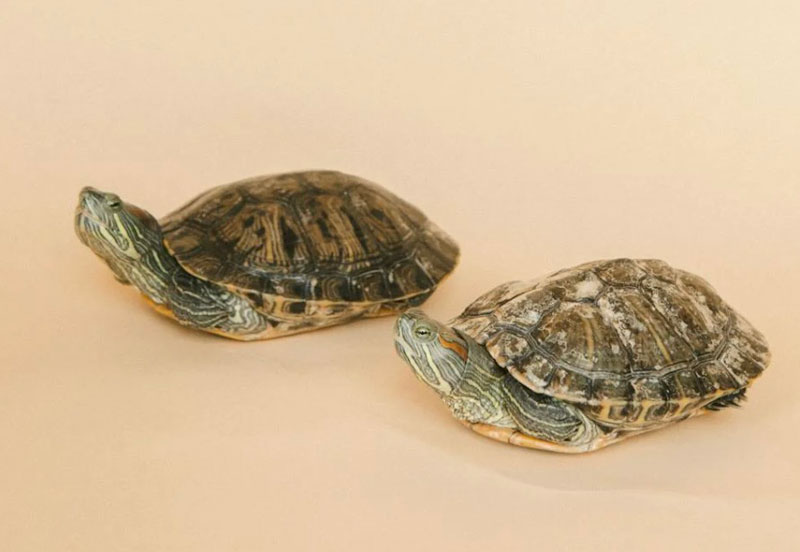How to Tell if a Turtle is Male or Female?
How to tell if a turtle is male or female? Determining the gender of a turtle can be crucial for their care and breeding. While it may seem challenging due to their similar outer appearance, there are specific physical traits you can observe to distinguish between a male and female turtle. This guide will walk you through the key indicators such as shell size and shape, claw length, tail size, cloaca, and coloration to help you identify your turtle’s gender with confidence.

Examining Shell Size and Shape
One of the primary ways to determine a turtle’s gender is by examining its shell. Male and female turtles have distinct differences in their shell shapes and sizes:
Shell Size: Generally, female turtles tend to be larger than their male counterparts. This size difference can be due to the need for females to carry eggs. The larger shell provides more space for this purpose.
Plastron Shape: The plastron, or the bottom part of the shell, is often concave in males, making it easier for them to mount females during mating. Females usually have a flat or slightly convex plastron to accommodate egg-carrying.
Carapace Shape: Males might have a more elongated carapace (upper shell), while females often exhibit a rounder, wider carapace. This difference is another adaptation linked to reproductive roles.

Checking Claw Length
Claw length is another tell-tale sign of a turtle’s gender. This is especially noticeable in species like the red-eared slider:
Male Claws: Males typically have longer, more pronounced claws on their front legs. These long claws are primarily used during mating rituals, where the male will use them to stimulate the female.
Female Claws: Females have shorter, more uniform claws, as they do not need them for mating purposes. Instead, their claws are mainly used to dig nests for laying eggs.
Claw Curvature: In some species, not only do males have longer claws, but their claws also tend to be more curved than those of females. This curvature aids in mating by allowing better grip on the female’s shell.
Measuring Tail Size
Tail size is another critical gender indicator in turtles. The differences in tail length and thickness are often more obvious in adults:
Male Tails: Males generally have longer and thicker tails, which house their reproductive organs. The tail also ends in a distinct, more pronounced point.
Female Tails: Females have shorter, thinner tails. The cloaca, or vent, also sits closer to the body when compared to males. This adaptation helps protect their reproductive organs.
Tail Placement of Cloaca: In males, the cloaca is located further from the base of the shell, near the tip of the tail. In females, it is closer to the body, making this a reliable indicator when comparing mature turtles.
Look at Cloaca
The cloaca, an opening used for excretion and reproduction, offers notable differences between genders:
Male Cloaca: Positioned further down the tail, near the tip. This placement helps males during mating.
Female Cloaca: Found closer to the base of the tail, nearer to the body. This location aids in laying eggs.
Visual Inspection: Observing the position of the cloaca can be a definitive method for determining gender, especially in adults. It’s less apparent in juveniles, so consider other factors if you’re examining a young turtle.
Inspect Coloration
Coloration can also help differentiate between male and female turtles, particularly in certain species:
Males: May exhibit brighter, more vibrant colors. This is often related to mating displays and attracting females.
Females: Typically have duller, more subdued coloration. This helps them remain inconspicuous while nesting and caring for eggs.
Species-specific Colors: For example, male red-eared sliders often have darker markings, while females tend to maintain a more uniform color.
Conclusion
Determining whether your turtle is male or female involves examining various physical traits, including shell size and shape, claw length, tail size, cloaca, and coloration. While individual characteristics can vary and some turtles may not exhibit all these differences, considering these factors together can help you make a confident determination. By understanding these gender-specific features, you can better cater to the needs of your turtle, ensuring its health and well-being.
FAQ
Do male or female turtles have red eyes?
In some species, such as the box turtle, male turtles can have red or orange eyes, while females typically have brown or yellow eyes. Eye color can sometimes be a useful secondary indicator of gender, though it should not be the sole characteristic used for identification.
How do I tell the gender of my red-eared slider?
To tell the gender of a red-eared slider, look for long claws on the front legs, a longer and thicker tail, and the position of the cloaca. Males have longer claws, thicker tails with the cloaca situated further from the body, and a more pronounced point at the tip of their tail.
Are female turtles bigger than males?
In many species, yes, female turtles are generally larger than males. This size difference is often linked to reproduction, as larger females can carry more and larger eggs. The larger shell size in females provides ample space for egg development and laying.
